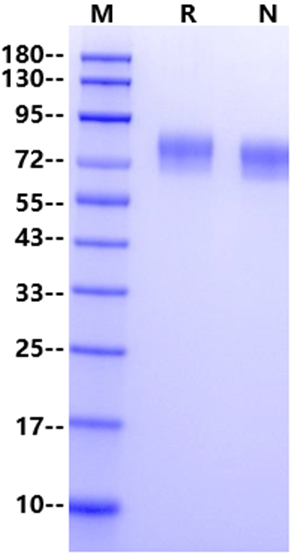Gln22-Ser490, with C-terminal 8*His QDTFTAAVYEHAAILPNATLTPVSREEALALMNRNLDILEGAITSAADQGAHIIVTPEDAIYGWNFNRDSLYPYLEDIPDPEVNWIPCNNRNRFGQTPVQERLSCLAKNNSIYVVANIGDKKPCDTSDPQCPPDGRYQYNTDVVFDSQGKLVARYHKQNLFMGENQFNVPKEPEIVTFNTTFGSFGIFTCFDILFHDPAVTLVKDFHVDTIVFPTAWMNVLPHLSAVEFHSAWAMGMRVNFLASNIHYPSKKMTGSGIYAPNSSRAFHYDMKTEEGKLLLSQLDSHPSHSAVVNWTSYASSIEALSSGNKEFKGTVFFDEFTFVKLTGVAGNYTVCQKDLCCHLSYKMSENIPNEVYALGAFDGLHTVEGRYYLQICTLLKCKTTNLNTCGDSAETASTRFEMFSLSGTFGTQYVFPEVLLSENQLAPGEFQVSTDGRLFSLKPTSGPVLTVTLFGRLYEKDWASNASSGGGSHHHHHHHH
1. Hu Lei, Han-Zhang Xu, Hui-Zhuang Shan, Meng Liu, Ying Lu, Targeting USP47 overcomes tyrosine kinase inhibitor resistance and eradicates leukemia stem/progenitor cells in chronic myelogenous leukemia. Nat Commun. 2021 Jan 4; 12(1):51.
Vanin 1, or pantetheinase, is a glycosylphosphatidylinositol(GPI)-anchored ectoenzyme that has been shown to be widely expressed in many tissues, including the liver, kidney and gut. Pantetheinase catalyzes the hydrolysis of pantetheine to pantothenic acid (vitamin B5) and cysteamine, which together with cystamine participate in the regulation of cellular pathways involved in oxidative stress and inflammation. Germline deletion of vanin 1 in mice results in an absence of tissue cysteamine. As such, vanin 1 has been shown to both protect tissues from and sensitize tissues to damage in different disease settings.Mice that lack vanin 1 display resistance to oxidative tissue damage induced by whole-body γ-irradiation, with a reduction in apoptosis and inflammation. The absence of cellular cysteamine was associated with elevated levels of the potent antioxidant glutathione.

1μg (R: reducing condition, N: non-reducing condition).